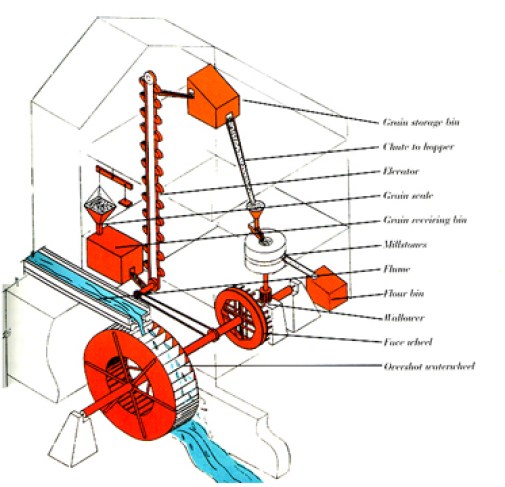
Gears
A lot of life involves turning raw materials into useable products, like baking raw potatoes or sending middle-graders to school.
While some say ‘Knowledge is Power’, knowing how many dairy cows are in the world won’t put milk on your cereal.
Someone has to milk the cows, and put the milk into the supply-chain, as it is called.
A balanced supply-chain requires work, and gears are a major help for people doing work.
To do big work, or a lot of smaller jobs, we need lots of people or we need machines. Or both.
When we use machines, we need some form of energy to power the machines.
Remember:
Energy, transformed into power, makes machines work, which produces things we need.
Power wasn’t created with the first electrical generator or the first internal-combustion engine.
There has been power available to people throughout human history.
Barton ate cornbread, made of cornmeal, which was milled at a water-powered gristmill on the North Raccoon River. The flowing river was energy available for use. The water wheel transformed water-energy into power, and the gears carried that power to the millstones that ground the corn. See how that works, in the drawing above?
In Elkhorn Iowa, there sits a wind-powered gristmill, built in Denmark in 1848, just before Barton's family moved to Iowa.
It was disassembled and moved to Elkhorn 1976, a town full of Danish descendants.
The wind blows through the 'sails' or 'vanes', turning the 'wind carousel', as I call it.
And the central shaft of the wind carousel then turns the the main shaft in the mill.
Power is then transmitted to the machinery that grinds grains.
Other mills might saw wood, or pump water.
Gears carry power translated from water energy or wind energy.
Water wheels translate water energy into mechanical power.
Sails or vanes on windmills translate wind energy into mechanical power.
Sails or vanes on windmills translate wind energy into mechanical power.
This energy-to-work formula is also true with steam locomotives.
The energy is in the coal or wood, burned in the firebox of the boiler.
The steam boilers produce thermal energy, which is converted into mechanical energy, which turns the driving wheels of the locomotive, which is the real job of the locomotive.
It just takes a lot of parts to get from the raw coal to the turning wheels.
And then, that same locomotive often hauled even more coal to power other locomotives and river boats.
But, back to the watermill that supplied Barton's cornmeal. The North Raccoon River was the energy.
The waterwheel converted that energy into power.
The gears transported the power to the millstones that made the cornmeal.
The watermill used the water that flowed horizontally to make the grinding wheel turn in a circle.
This was done with gearing, as the illustration shows.
Now, when I talk about gearing, I include belts and pulleys in the discussion.
My Grandma Bertie, a paper-hanger and quiltmaker, used a treadle-powered sewing machine to make quilts.
The same way Masie Crawford made Barton's quilt.
The foot-powered treadle made a belt go around, and powered the sewing machine.
Grandma was the source of energy.
My Grandpa Harry was a farm-hand for many years. Early-on, they farmed with horses.
Then his boss bought a tractor for the big work.
Power tractors were used on farms before electricity was available for most famers.
So, tractors had side pulleys that turned flat belts, to power sawmills, threshing machines and feed grinders.
Notes:
1) The illustration above is from ‘The tide Mill Institute’. A tide mill is another type of water-powered mill you can learn about.
Website: https://www.tidemillinstitute.org/grist-mills/
2) The windmill in Elkhorn, Iowa gives tours. Website: https://www.danishwindmill.com/
3) As a teenager, my grandparents took me to an old-fashioned farm show in Mt. Pleasant Iowa, where we saw different types of machinery, including working steam-powered tractors. Website:
https://www.oldthreshers.com/
Throughout the nation, museums, exhibits and events exist to show you these kinds of things.
Consider this for a family edu-vacation
Eric J. Rose
middlegrademysteries.com
Photo: passionforthepast.blogspot.com